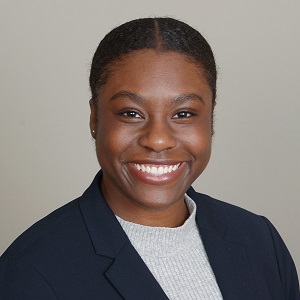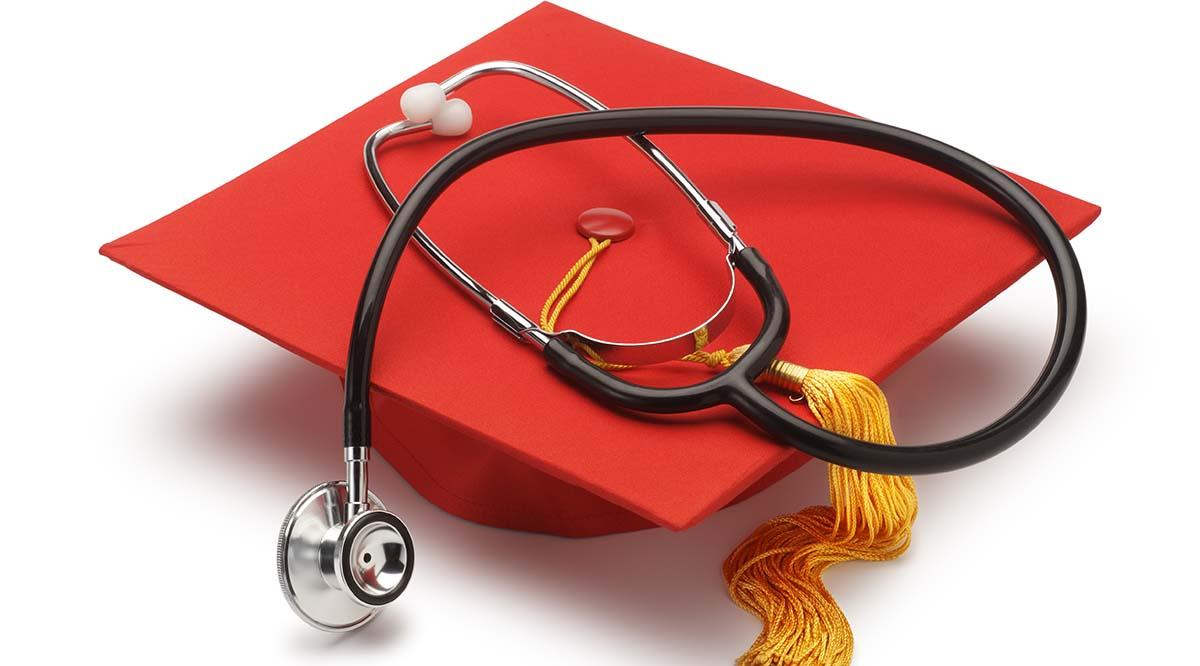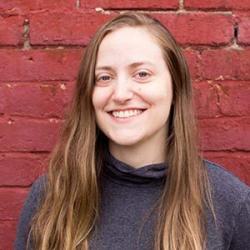As the eldest daughter of immigrants from Ghana and Jamaica who met in physician assistant school, Jada Ohene-Agyei knew from a young age that she wanted to become a doctor.
“I think it goes back to my parents being in the medical field, I spent a lot of time around them and their coworkers,” she says. “And I always had an inclination towards math and science, so I think that [medicine] was something that was kind of a natural path for me.”
Inspired by her parents’ experience attending an accelerated bachelor’s and physician assistant program, Ohene-Agyei applied to several higher education institutions that offer combined — and in some cases, accelerated — undergraduate and medical school programs.

Now, at age 23, Ohene-Agyei is in her fifth year of the University of Missouri-Kansas City (UMKC) School of Medicine’s six-year BA/MD program. In fact, she is currently earning a master’s degree before completing her final year of medical school, which starts in July.
Ohene-Agyei is on track to join a small percentage of physicians who matriculate from combined baccalaureate/MD programs: just 3.3% in 2022, according to the AAMC’s Medical School Graduation Questionnaire, although that’s up slightly from 2.8% in 2018.
More than 40 medical schools across the United States offer these combined degree programs and they vary widely in their approaches: from the accelerated six-year BA/MD program at UMKC that starts medical school coursework in the second year, to the eight-year program at Brown University in Providence, Rhode Island, that emphasizes obtaining a liberal arts undergraduate education before beginning the medical school curriculum, to many approaches in between.
But all share a similar purpose: to smooth the path to medical school for young people who are confident in their commitment to becoming physicians.
Accelerated programs for excelling students
Programs that compress undergraduate and medical school to six or seven years are particularly competitive and are targeted at a particular kind of high school student who is ready to jump into medical education headfirst.
“[Some of] these are students who … have known since they were first graders that they wanted to be doctors,” says Mary Anne Jackson, MD, dean of the University of Missouri-Kansas City School of Medicine and an alumna herself. “This program requires a high level of maturity and focus for our students, and I think we’ve done a pretty good job of choosing those students who are able to tackle this very compressed curriculum. And not only do they tackle it and are successful, but honestly, they blow my mind in terms of how bright they are. I have a first-year student right now who, if you looked at her CV, you’d swear she’s a faculty member.”
At UMKC, which is one of just a few six-year programs in the country, the application process is more rigorous than for undergraduate school. In addition to needing excellent ACT scores, GPAs, volunteerism, and strong personal statements, prospective students go through a series of mini-interviews that test their maturity, problem-solving skills, and capacity for empathy, Jackson says.
“We get a large number of really talented students who come through,” she adds.
But even though those who are accepted are high-achieving students, the course load can be challenging.
Ohene-Agyei recalls the adjustment she and her fellow students had to make in their first year, taking 20 or more credits per semester and working through the summer.
“It’s a lot,” she says. “And that was the first time most of us had gone without a summer break, so that was an adjustment, but I think the good thing about this program is that it is easy to build a camaraderie with your classmates early on in the program because you do go through so much together.”
In her second year, Ohene-Agyei was already moving from the dorms to her own apartment, and by her third year she was fully immersed in medical school. To help with the adjustment, students are assigned a physician mentor who leads a group of 10 or so students in the clinical setting and teaches them about patient care, professionalism, and healing.
It’s a system that prepares graduates to excel in their medical careers, Jackson says. She recalls her first week as a resident after completing the six-year program herself in the late 1970s when her co-residents and senior residents were amazed at how well she could handle multiple complex cases so quickly.
“Part of what I call our ‘secret sauce’ is that early introduction into clinical medicine,” Jackson says.
Ohene-Agyei acknowledges the path isn’t for everyone. She knows many successful medical students who wanted to explore different disciplines during their undergraduate years before fully committing to their studies in medicine. But for some students, like her, it’s a great fit.
“In my case, the six-year program [gives me] an extra two years that a lot of people don't get, so I was able to capitalize on my interest in research,” Ohene-Agyei says. “[I was able to] get a master’s degree and then be able to go back and finish my last year of medical school, and I’m still one year ahead of the people who I graduated high school with. So if you think about it that way, you’re saving time, you’re saving money, and you’re still getting that full range of everything you need to be a good doctor.”
Reaching the underrepresented
Several accelerated programs, including UMKC’s, were founded, at least in part, to recruit the brightest students from their region in the hopes that those students would stay beyond medical school to provide care in their home state.
About 70% of the students accepted to UMKC’s accelerated program are from Missouri and about half end up going into primary care specialties.
The University of Texas Rio Grande Valley (UTRGV) School of Medicine, located near the southernmost tip of Texas, started its Early Medical School Acceptance Program three years ago, specifically offered to students from South Texas. It is already matriculating its first class into medical school, since some students are completing their undergraduate requirements in three, or even two, years, says Guillermo Canedo, program manager for UTRGV’s pathway programs.
“The whole point is for them to come back and give back to the community,” Canedo says. “South Texas has a big diabetes and obesity problem, and we always need good doctors in RGV.”
The seven-year BS/MD program at the City University of New York School of Medicine (CUNY Med), which launched in 2016, also prides itself on recruiting New Yorkers and serving New Yorkers. In addition, the program specifically reaches out to students from backgrounds that are underrepresented in medicine.
More than 60% of CUNY Med’s students are from racial groups that are underrepresented in medicine, 85% come from low-income or disadvantaged households, and 80% speak a language other than English, says Carmen Renée Green, MD, dean of CUNY Med.
“All of those things play a part in who our students become,” Green says.
In the 2023 Match®, 100% of the class matched into a residency program, with more than 50% of them matching into primary care specialties and 75% staying in the New York City area.
“We are New York City’s medical school. We sit here among a lot of private medical schools who do fine work, but we’re the only public medical school,” Green says.
“We have a deep commitment to serving New Yorkers and our neighbors, and eliminating educational and health care inequities. What we do is changing the face of medicine in NYC by addressing both the social determinants of medical education and the social determinants of health,” Green adds.
Encouraging a humanistic approach to medicine
About half of the early acceptance programs in the country allow students the full eight years to complete both degrees.
Brown University, the only Ivy League institution to offer an early acceptance program, encourages students to focus on the liberal arts during their undergraduate years, before moving into the science-heavy medical curriculum.
Students admitted to Brown’s Program in Liberal Medical Education (PLME) need not take the usual required premed courses or even take the MCAT®. Instead, students are already admitted to Warren Alpert Medical School of Brown University so that they can focus on fully appreciating an undergraduate education in the liberal arts.
“The idea behind the PLME program is to have our students take advantage of our open curriculum here at Brown,” says B. Star Hampton, MD, senior associate dean of medical education at the medical school. “So hopefully, they can use the time and the mental space afforded to them by not needing to concentrate on [the sciences and premed studies] prior to matriculating to med school [to focus on] self-care and balance and their wellness, in addition to exploring and finding out what drives them and what motivates them.”
The hope, she explains, is that students will enter medical school with a humanistic approach to medicine and a more thorough understanding of the world through their liberal arts studies.
Of course, the admissions committee is looking for a very particular kind of student who is high achieving academically and well rounded, deeply interested in the liberal arts, but also sincerely committed to becoming a physician. And it is a very competitive program. Out of 3,516 applicants last year, just 87 were offered admission.
Acknowledging the setbacks
Early acceptance and accelerated baccalaureate/MD programs have been successful for many students. But they’re not for everyone — and they’re also not always successful at every institution.
Northwestern University’s Feinberg School of Medicine and the University of Nevada, Reno (UNR) School of Medicine have both recently suspended their accelerated programs.
UNR has paused to reevaluate the benefits of the program to students and its alignment with the school’s mission.
The program was originally designed more than a decade ago to stem the “brain drain” of bright young Nevadans who were leaving the state to attend medical school and practice medicine elsewhere, explains Aaron Dieringer, MD, assistant dean of admission at UNR School of Medicine. It started as a seven-year program, but in 2017, school administration changed it to eight years.
“What we found over that time was that three years limited students in how much they could experience in college in terms of personal growth,” Dieringer says.
Some students said that they weren’t able to take advantage of undergraduate experiences, such as studying abroad or exploring electives, and others said the stress of the compressed schedule was hard on their mental health.
About two years ago, the university’s leadership stopped accepting applications for the program and has been reconsidering how best to serve students as well as its mission to retain physicians in the state.
“There’s a lot of professional development that is involved in becoming a physician,” Dieringer says. “When is the best time [for students] to say, ‘I want to be a physician. I’ve done that exploration.’? ... At what stage do students really have that growth to show that they are ready to make that commitment?”
The answers to these questions are likely different for every institution and every student, he acknowledges.
But for those few students who feel confident about their calling to medicine, early acceptance to medical school can take some of the anxiety and uncertainty out of the process of fulfilling their dream.
As Ohene-Agyei advises high schoolers who are considering applying to an early acceptance program: “If you know 100% in your heart that medicine is the path for you and you want to be a doctor, I would absolutely go for it.”

